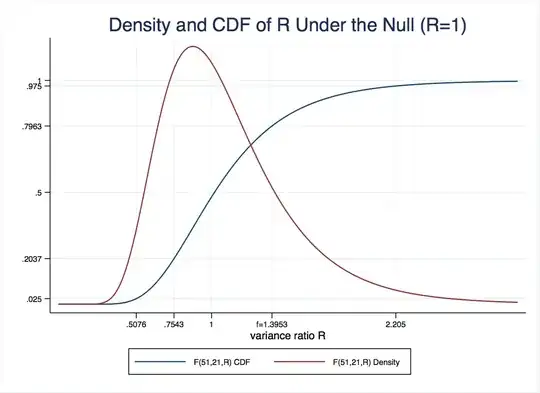Here's an example using the auto dataset, where we compare the variance of foreign and domestic automobile prices:
. #delimit;
delimiter now ;
. sysuse auto, clear;
(1978 Automobile Data)
. sdtest price, by(foreign);
Variance ratio test
------------------------------------------------------------------------------
Group | Obs Mean Std. Err. Std. Dev. [95% Conf. Interval]
---------+--------------------------------------------------------------------
Domestic | 52 6072.423 429.4911 3097.104 5210.184 6934.662
Foreign | 22 6384.682 558.9942 2621.915 5222.19 7547.174
---------+--------------------------------------------------------------------
combined | 74 6165.257 342.8719 2949.496 5481.914 6848.6
------------------------------------------------------------------------------
ratio = sd(Domestic) / sd(Foreign) f = 1.3953
Ho: ratio = 1 degrees of freedom = 51, 21
Ha: ratio < 1 Ha: ratio != 1 Ha: ratio > 1
Pr(F < f) = 0.7963 2*Pr(F > f) = 0.4073 Pr(F > f) = 0.2037
The observed ratio of variances is $f=1.3953$. Under the null that $R=1$, the variance ratio $R$ is distributed as $F(51,21)$. The degrees of freedom of the $F$ distribution are the numbers of observations in each group less one (since we had to estimate two means). This distribution looks like this:

As you can see, the observed ratio is near the center of the distribution, so we are unlikely to reject the null.
More formally, the $p$-value is the probability that we observe a test statistic $R$ at least as large as the one we saw, $f=1.3963$, under the null distribution above. For the one-tailed test where the alternative hypothesis is $R<1$, that is
$$P(R < 1.3953)=F(51,21,1.3953)=0.7963.$$
You can read that off from the CDF (blue line) or use the display F(51,21,1.3953) in Stata. For the other two-tailed test, where the alternative is $R>1$, we need $$P(R>1.3953)=1-P(R<1.3953)=0.2037.$$
The two-tailed test is somewhat more complicated. We basically need $P(R>1.3953)=0.2037$, plus the corresponding probability that $R$ is extremely small, which happens to be the same, and corresponds to the probability $P(R<0.7543)=0.2037$. That is why Stata just reports two times the $p$-value for the $H_a:R>1$ one sided test. If we observed that $f<1$, you would use the $p$-value for the other one (try sdtest mpg, by(foreign) for one example).
Finally, @gung and @NickCox's comments about non-robustness of the $F$ test (and Bartlett’s generalization of it to more than two groups) should not be ignored. In Stata, you can implement Levene’s test with:
. robvar price , by(foreign)
| Summary of Price
Car type | Mean Std. Dev. Freq.
------------+------------------------------------
Domestic | 6,072.423 3,097.104 52
Foreign | 6,384.682 2,621.915 22
------------+------------------------------------
Total | 6,165.257 2,949.496 74
W0 = 0.23429053 df(1, 72) Pr > F = 0.6298296
W50 = 0.00098009 df(1, 72) Pr > F = 0.97511185
W10 = 0.03306479 df(1, 72) Pr > F = 0.85622141
The $W_0$ is Levene's robust statistic and $0.6298296$ is the $p$-value for the null that the variances are all equal, with the alternative that at least one pair is not. The $W_{50}$ replaces the group-specific means in the test statistic formula with the medians and $W_{10}$ replaces them with the 10% trimmed mean. There's some simulation evidence that the median performs better in terms of robustness and power when the data are skewed, while the the trimmed mean is well suited for fat-tailed distributions. The mean is intended for symmetric, moderate-tailed distributions. Arguably, the median is the one to use here, though it doesn't matter.
This $W_0$ is distributed $F(1,72)$, so we can calculate the $p$-value as $$1-P(W_0<0.23429053)=.6298296.$$ The degrees of freedom are given by the number of groups less one, and the total number of observations less the number of group-specific means.
